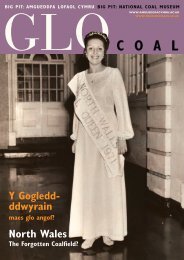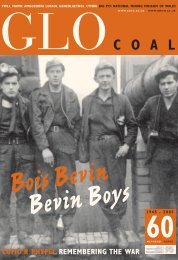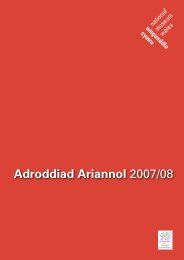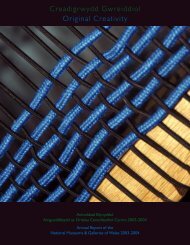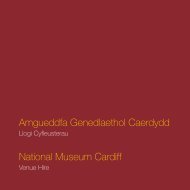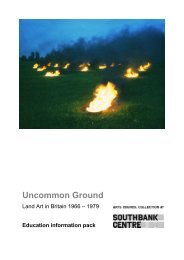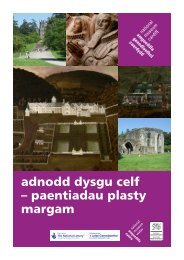Create successful ePaper yourself
Turn your PDF publications into a flip-book with our unique Google optimized e-Paper software.
Fe wnes i sawl tirlun o byllau glo hefyd, weithiau’n<br />
uniongyrchol ar gynfas, dro arall yn frasluniau i’w<br />
datblygu’n ddiweddarach yn fy stiwdio. Un diwrnod,<br />
roeddwn i’n gwneud braslun o Lofa Merthyr Vale ac<br />
wedi ymgolli’n llwyr yn fy ngwaith, pan sylwais ar<br />
ryw siâp petryal gwyn ar ochr y bryn gyferbyn.<br />
Sylweddolais mai beddi’r plant a fu farw yn<br />
nhrychineb Aber-fan oeddynt.<br />
Yna, cefais wahoddiad gan British Coal Opencast<br />
i wneud casgliad o luniau ar y testun; treuliais<br />
flwyddyn yn ymweld â Ffos Las (maes rasio ceffylau<br />
heddiw), East Pit Extension a Nant Helen. Tipyn o<br />
olygfa oedd y lorïau dadlwytho’n mynd a dod yn ddibaid<br />
a gweld y safle’n newid o ddydd i ddydd. Roedd<br />
yr haf yn chwilboeth a’r gaeaf yn rhynllyd ar y safle<br />
siâp powlen. Tra’r oeddwn i ar y safle, cefais set radio<br />
symud a siarad (walkie-talkie) er mwyn gofyn am li<br />
yn ôl i’r swyddfeydd, ond weithiau byddwn i’n cael<br />
li gan lori ddadlwytho. Y tro cyntaf i mi weld<br />
ffrwydrad ar y safle, roedd yna fwg oren yn codi a<br />
meddyliais ei fod yn lliw gwych i’w ychwanegu at fy<br />
lluniau – ond esboniodd rhywun gyda chywilydd mai<br />
arwydd o danio gwael oedd hynny. Ond fe’i<br />
defnyddiais yr un fath! Roedd croeso i mi weithio yn<br />
lle mynnwn, gyda’r peiriannau’n mynd a dod o’m<br />
cwmpas. Roeddwn i wedi ymgolli’n llwyr yn fy<br />
ngwaith yng nghanol y sŵn byddarol pan deimlais<br />
ryw hen wynt oer, a throis i weld bod y sied fawr ar<br />
slediau a oedd union tu cefn i mi wedi’i symud –<br />
doeddwn i fawr callach oherwydd y dwndwr!<br />
Cacophony oedd yr enw a roddais ar y llun.<br />
Dros y blynyddoedd, dwi wedi astudio pob math o<br />
destunau gwahanol, o flwyddyn gyda’r Central School<br />
of Ballet, Llundain, llwyfannau olew yn anialwch<br />
Patagonia, dilyn Syrcas Wladol Moscow o amgylch y<br />
wlad, chwe mis yng Ngharchar Abertawe, gwyliau jazz<br />
ac, yn fwy diweddar, cerddorion clasurol. Ond roedd<br />
y project gwaith glo, yn enwedig y flwyddyn a dreuliais<br />
yn Six Bells, yn wych yn ogystal â’r cyfnod ym Mhwll<br />
y Tŵr pan oedd yn nwylo’r gweithwyr. Dyna’r profiad<br />
mwyaf gwerthfawr a gefais erioed, sef cipolwg go iawn<br />
ar fyd mwyngloddio ac mae gan y pwnc apêl arbennig<br />
i mi hyd heddiw. Mae gennyf tua 300 o lyfrau braslunio<br />
sy’n llawn o luniau o’r holl brojectau y bues i’n<br />
gysylltiedig â nhw, ac mae’n amlwg pa rai sy’n perthyn<br />
i’r glofeydd – y rhai mwyaf brwnt!<br />
Mae Cymunedau yn Gyntaf yn cymryd camau<br />
breision wrth helpu i adfer Six Bells yn sgil y bwlch<br />
anferthol a adawyd ers difodiant y diwydiant glo. Un<br />
o’r camau mwyaf beiddgar a chyffrous oedd<br />
comisiynu’r cerflun Gwarcheidwad, yn yr un modd â<br />
chreu canolfan amlbwrpas ar gyfer addysg,<br />
twristiaeth a hamdden sy’n prysur droi’n ganolbwynt<br />
i ymwelwyr niferus Six Bells.<br />
Valerie Ganz<br />
Ewch i www.valerieganz.co.uk am ragor o wybodaeth<br />
am Valerie Ganz.<br />
e men were the usual crews of hardworking,<br />
good-natured men with a bizarre sense of humour. I<br />
was drawing one face worker, he was the butt of the<br />
usual humour from passing crew, and one of them<br />
said “don’t forget his earring, he has only been wearing<br />
it since his wife found it on the back seat of the car”.<br />
I also made several landscape paintings of mines,<br />
sometimes direct onto canvas, at other times sketches to<br />
be developed back at my studio. One particular day I was<br />
sketching Merthyr Vale Colliery and was totally engrossed<br />
in what I was doing, when I became aware of a white<br />
oblong patch on the hillside opposite. I realised it was the<br />
graves of the children killed in the Aberfan disaster.<br />
I was then invited by British Coal Opencast to make<br />
a collection of work on the subject; I spent a year<br />
visiting Ffos Las (now a race course) East Pit Extension<br />
and Nant Helen. It was fascinating to see the dumper<br />
trucks constantly on the move and the way the site<br />
changed from day to day. In summer it could be<br />
sweltering in the site bowl and in winter absolutely<br />
freezing. When I was on site I was given a walkie-talkie<br />
so that I could tell them when I wanted a li to go back<br />
to the offices, but sometimes I got a li on one of the<br />
dumper trucks. e first time I saw blasting on a site,<br />
I saw orange fumes coming up and thought it was great<br />
colour and would add to the subject, but I was told with<br />
some embarrassment, that that was a sign of a bad blast,<br />
but I still used it! I was allowed to work wherever I liked<br />
with the machinery moving all around me. e noise<br />
was deafening, and I was engrossed in my work when<br />
I became aware of a cold draught and turned around<br />
to find that the big shed on sledges that had been<br />
directly behind me, had been moved away, the noise<br />
had been so loud I had not heard any extra activity. e<br />
resulting painting I called “Cacophony”.<br />
Over the years I have studied various subjects, a<br />
year in London at the Central School of Ballet, at oil<br />
rigs in the Patagonian Desert, followed Moscow State<br />
Circus around the country, six months at Swansea<br />
Prison, Jazz festivals and more recently classical<br />
musicians. But the coal-mining project especially the<br />
year spent in Six Bells was fantastic then leading onto<br />
to working in Tower colliery when it was owned by<br />
the miners. is was a most rewarding experience that<br />
gave me real insight into the world of mining and still<br />
holds a special fascination for me. I have about three<br />
hundred sketchbooks full of work from all the<br />
projects I have been involved with, but you can always<br />
see which the collieries ones are as they are so dirty.<br />
e regeneration of Six Bells by Six Bells Communities<br />
First is making amazing strides in developing the area to<br />
replace the huge void le by the demise of the coal<br />
industry. Commissioning the sculpture “Guardian” was a<br />
bold move as is creating a multi purpose centre for<br />
education, tourism and recreation, which is becoming a<br />
focal point for the many visitors to Six Bells.<br />
Valerie Ganz<br />
For further details of the work of Valerie Ganz visit -<br />
www.valerieganz.co.uk<br />
Y Gof<br />
The Blacksmith<br />
Cefais fy ngeni yn Nhretomas ym 1930. Dwi’n<br />
dod o deulu glofaol, a bu fy nhad, Idris<br />
omas, yn oferman yng Nglofa Bedwas. Pan<br />
adewais i’r ysgol ym 1944, roeddwn i am weithio ar<br />
Ystâd Fasnachu Trefforest ond, er i mi gael gwaith fel<br />
ffitiwr, ni fyddwn wedi dechrau tan fis Hydref, felly<br />
cefais swydd yn y lofa yn lle hynny. Glywes i erioed y<br />
fath iaith anweddus tan i mi gael cyfweliad gyda’r lofa<br />
– roedd y fforman yn dweud, ‘If you can’t work<br />
******* seven days every week, you’re no ******* good<br />
to me!’. Wrth gwrs, rydych chi’n clywed pobl yn rhegi<br />
yn gyson heddiw, ond yn y dyddiau hynny, roeddech<br />
chi’n gadael y rhegi yn y pwll.<br />
Dechreuais weithio fel morthwyliwr gyda’r gof, ac<br />
ym Medwas y bues i am y deugain mlynedd nesaf –<br />
roeddwn i’n nabod pob twll a chornel o’r lle!<br />
Gweithiais am ddwy flynedd gyda gof o’r enw Frank<br />
Cotrell a ddysgodd bopeth i mi – a’m cario mewn<br />
gwirionedd, gan nad oeddwn i’n dal iawn, ac ni<br />
fyddai byth yn gadael i mi godi unrhyw beth trwm.<br />
Roedd yn gwneud ei dŵls ei hun, ac roedden nhw<br />
mor dda nes bod rhai o’r gofaint eraill yn eu benthyca<br />
nhw. Roedd cryn dipyn o waith rhybedu ym Medwas,<br />
gyda’r holl dramiau a chaetsis wedi’u rhybedu at ei<br />
gilydd bryd hynny, a dysgodd Frank fi i dwymo<br />
rhybedion ar y tân. A dyna wnes i gydol fy nyddiau<br />
gwaith.<br />
Ar ôl dwy flynedd, gadawodd gwas y fforman<br />
cynorthwyol a chefais innau fy newis yn ei le. Dyma’r<br />
ychydig fisoedd mwyaf diflas a dreuliais erioed gan<br />
mai gaeaf 1947 oedd hi, ac roeddwn i ar rewi yng<br />
ngefail y gof. Roedd yr efail yn gynnes braf, wrth<br />
gwrs, ond fel morthwyliwr, roeddwn i’n gweithio y tu<br />
allan i’r efail ei hun. Hen fochyn o ddyn oedd y<br />
Iwas born in Trethomas in 1930. I come from a<br />
mining family, my father, Idris omas, was an<br />
overman in Bedwas Colliery. When I le school<br />
in 1944 I wanted to work in Treforest Trading Estate<br />
but, although I got a job as a fitter, I wouldn’t have<br />
started until October so I got a job in the colliery<br />
instead. I had never heard bad language until I had<br />
the interview for the colliery – the foreman said “If<br />
you can’t work ******* seven days every week, you’re<br />
no ******* good to me!” Today you hear swearing all<br />
the time but in those days you le it behind in the pit.<br />
I started in the blacksmiths’ shop as a striker and<br />
spent the next 40-odd years in Bedwas – I knew every<br />
nut and bolt in the place! I worked for two years with a<br />
smith called Frank Cotrell and he taught me everything,<br />
in fact he really carried me as I wasn’t very big and he<br />
wouldn’t let me li anything heavy. He made all his own<br />
tools and they were so good some of the other smiths<br />
used to borrow them. ere was a lot of riveting work<br />
in Bedwas, the trams and cages were all riveted together<br />
then, and Frank taught me how to warm rivets on the<br />
fire and I did that all my working life.<br />
Aer two years the assistant foreman’s boy le and he<br />
picked me in his place. is was the most miserable<br />
couple of months I spent as it was the winter of 1947 and<br />
I was freezing to death in the blacksmiths. e forge was<br />
warm, of course, but I was the striker and worked away<br />
from the actual forge. e foreman was a pig of a man<br />
who had been a scab when the scab union was at Bedwas.<br />
is particular fellow shouldn’t have been allowed to have<br />
a dog let alone look aer a boy, he used to criticize me all<br />
the time even though he didn’t take any pride in his own<br />
work. I wanted to leave but my father persuaded me not<br />
to as I would have been conscripted into the Army.<br />
56 57





